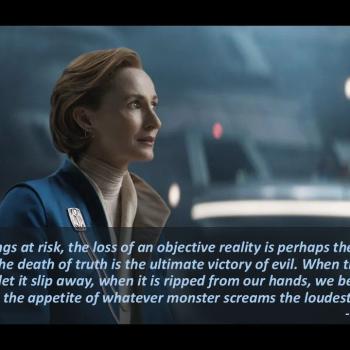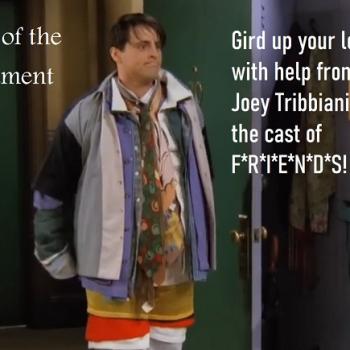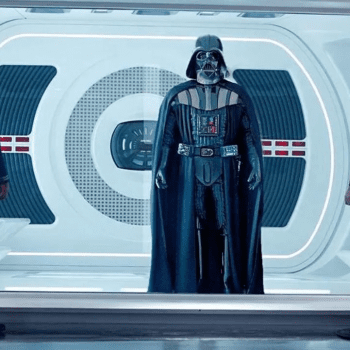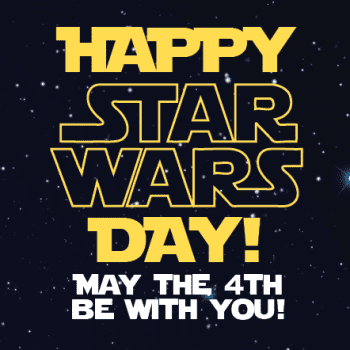I went to see The Last Jedi yesterday afternoon. This post will contain spoilers. If you have yet to see the movie and wish to experience it without having heard about things that happen during it, this would be a good time to stop reading. Bookmark this post and come back after you’ve seen it. Others of you have been eagerly looking for opportunities to talk about the details of the movie with those who have already seen it, and this is one such opportunity.
Let me start by saying that, on the whole, I really like the direction that the movie took with pretty much every element: the Jedi order, the Force, heroism, leadership, child-parent relationships (including the mystery surrounding Rey’s parents), and many other things. The movie was full of humor, which Star Wars always has been, but the humor here seemed different somehow, and on the whole I think it worked well. The movie has many aspects that echo not merely The Empire Strikes Back but also Return of the Jedi, yet with striking surprises and inversions of those elements too. A Jedi in search of training. Two apprentices standing before a dark side master sitting on a throne, each believing that the other will turn. Starting the second movie in this trilogy with an evacuation. A white planet with walkers closing in on a rebel base. All of this seemed to appropriately continue themes from The Force Awakens, and maintain the emphasis that history is cyclical, that every generation must navigate conflict, teaching, parenting, economics, and other perennial matters. None of them are things that can be resolved once and for all as long as sentient beings exist in relationship with one another.
The opening sequence, in which Poe Dameron stalls for time while the resistance forces escape, makes for a nice bookend with the actions of Luke Skywalker towards the end of the film. The comical way in which he does so initially sets the tone for the movie’s humorous side, while his refusal to break off the attack on the Dreadnought also introduces the theme of heroism vs. leadership. As Leia will tell him later, she saw lots of (dead) heroes on that mission, but no leaders.
I also enjoyed seeing the movie jump to pick up where The Force Awakens left off, with Rey handing Luke his old lightsaber. I can’t think of a better following moment than what we were given, as Luke proceeded to toss it away over his shoulder. There were lots of moments in which a detail was not highlighted but nonetheless significant and poignant – such as when we saw Luke’s X-Wing in the water below the cliff, symbolic both of the connection to previous stories in the Star Wars saga, and also of his resolve that, having come to this world, he would never again leave it.
Snoke’s interaction with Kylo Ren early in the movie is reminiscent of, and yet harsher than, that of Emperor Palpatine/Darth Sidious with his apprentice Anakin Skywalker/Darth Vader. Snoke tells Kylo Ren to “take that ridiculous thing off” (referring to his helmet), and refers to him as a child in a mask rather than a new Vader living up to the potential of his bloodline (adding that he has “too much of his father’s heart”). Presumably the aim was to provoke anger and darkness in Kylo.
As a scholar of religion, I especially liked the theme of the original Jedi texts, their sacred books, located in a sacred tree. Indeed, at one point Luke recommends that Rey watch her language since they are on a sacred island, and alien “nuns” continue to maintain the location. In the midst of that original Jedi sacred location is a symbol reminiscent of the yin-yang from Taoism, and this delighted me, since Luke shows he had come to understand that the Force is “not a power you have,” and the light is not something that belongs to the Jedi. Balance (in relation to the Force) really does mean balance – between light and darkness, birth and death leading to new birth, peace and violence. Luke’s second lesson for Rey is that the Jedi had been mythologized and deified, but they had become corrupt and deeply flawed, allowing Darth Sidious to rise to power.
The interaction between Poe Dameron and vice admiral Holdo was also brilliant, and mirrored in many ways the hero’s journey of Luke Skywalker in the original trilogy, but in a different way. Poe relieves Holdo of her command thinking that the approach she is taking is wrong. But his plan fares no better, and we later not only come to share her judgment that Poe is “impulsive, dangerous, and the last thing we need right now,” but also to recognize her as a courageous leader willing to sacrifice herself for her people with a deep understanding of how to work for their good in a thoughtful manner, rather than one full of brashness and bravado but lacking in analysis, which is what Poe’s approach is like. Nevertheless, Holdo is able to appreciate Poe’s strengths and gifts as well, saying “That one’s a troublemaker…I like him,” to which Leia responds, “Me too.” And Leia will help Poe to see that Holdo was more concerned with protecting the light than seeming like a hero. And towards the end of the movie, Leia will ask, “What are you looking at me for? Follow him!”
One of my favorite parts was the visit to a planet full of the “worst people in the galaxy,” which turns out to not be like Mos Eisley full of scruffy-looking riff-raff, but an elegant casino where the rich spend their time. The way one becomes that rich is by selling arms, and the fact that many of them sold to both the First Order and the Resistance serves once again to blur facile distinctions between “good guys” and “bad guys.” When Finn says the place is beautiful, Rose suggests that he look closer. But as we’ll see when Rose risks her life to save Finn’s later in the movie, this doesn’t mean that there is no distinction between good and evil in the Star Wars universe. As she puts it, we won’t win by fighting what we hate, but by rescuing what we love.
We eventually learn that Luke, for a brief moment, considered killing Ben Solo, fearing the darkness that he felt rising in him. And so Luke failed him as a teacher, and pushed him in the direction that led him to destroy Luke’s new Jedi order. And while Rey goes to her moment that closely parallels Luke’s course towards the end of Return of the Jedi, Luke is visited by Yoda, who finds Luke ready to set fire to the ancient sacred tree and the books within it. Rather than stopping him, Yoda summons lightning and sets the whole thing ablaze, laughing heartily as he tells Luke that the wisdom in the books are things Rey has already learned. “The greatest teacher, failure is,” Yoda opines, emphasizing that generation to generation, teachers are always those that their pupils grow beyond. Later Luke will say that the Jedi will not die with him, because he has discovered that their tradition need not remain what it was at the most disappointing moments in its history, but can grow and evolve and transcend the past precisely as its adepts transcend their masters.
The pinnacle of the movie in many ways is the three-way interaction between Snoke, Kylo, and Rey. In a manner that is both like and unlike Return of the Jedi, Kylo kills his master. Red and blue lightsabers then fight side by side against the guards. After that, Kylo follows the path that Sith typically did, proposing that Rey now join him to bring a new order to the galaxy – to which she responds, “Don’t go this way.” In the end, they engage in a Force battle for Luke’s old lightsaber, until eventually it splits in two and the explosion knocks them out.
Before that, however, Kylo tells Rey about her parents, things that he suggests that she already knew deep down. They were nobodies. Her abilities are not because she is a Skywalker or a Palpatine or anything else. Sometimes people are gifted and it has nothing to do with who their parents were.
The final confrontation between Luke and Kylo was quite beautiful, as Luke, on the one hand, stalled to allow the rebels a chance to escape, while on the other offered an apology for having failed Kylo as his teacher, rather than being there to “save his soul.” We eventually learn that Luke’s presence there was an astral projection – he had not, in fact, physically left the island of Ahch-To where he had earlier sworn he would remain. In the end the exertion was all he could manage and he disappeared to become one with the Force. Rey and Leia sensed it, and Rey commented that it wasn’t a sad thing but a peaceful and purposeful one.
The ending was also a clever move. It starts with Rey asking Leia how they can build a rebellion from what they have there, and Leia responding that they have everything they need. It then returns to children that had encountered Rose and Finn earlier in the movie, now playing with action figures they have made and telling the story of Luke Skywalker, Jedi Knight. One of them is holding a broom, and we just know instinctively, even though we do not see it, that he will pretend it is a lightsaber, just as so many fans of Star Wars have done. And so the movie ends in a manner that is fitting in an exploration of our tendency to mythologize and deify our heroes, and to vilify even those who may be doing more for the cause of good as they make hard choices on behalf of everyone that heroes do not have to in the same way. Although it is liable to be overshadowed by our instinct to focus on those strong with the Force, it is perhaps the story of Rose and Finn that most clearly encapsulates this, as she moves from idolizing him, to disappointment with him, to a love that does not need to pretend that he is something other than an imperfect human being who is capable of cowardice and foolishness but also incredibly bravery and conviction. The Last Jedi, in very positive ways, complicates and yet simplifies the Force, good vs. evil, and other themes that often seemed at once too simplistic and too convoluted in other Star Wars movies. My only concern as the movie ended was that it seemed more of a natural lead-in to a serialization or comic book franchise, than something that would continue naturally in the grand epic blockbusters that previous Star Wars movies have been. But I loved the direction that the movie took, and so am happy to wait to find out where it will head from here.
This post would not be complete without a mention of the soundtrack. I thought that the movie’s new music and inclusion of familiar themes was balanced perfectly. Those who knew the music of all the earlier Star Wars movies would have recognized themes such as Luke and Leia at just the right moments.
If you’ve read this far, I assume you’ve already seen The Last Jedi. What did you think of it?
See also Paul Cornell’s blog post for more on religion and other things in the movie that literally moved him to tears.

















